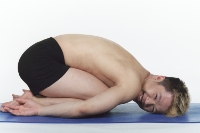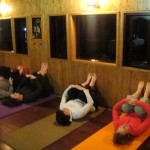Click here for: Wellness Program l Yoga l Research & Studies
 Restorative yoga is a new trend in the yoga industry. This type of yoga is good for someone with limited mobility. Instead of moving and mastering your body, you lie in a yoga position and relax into the pose.
Restorative yoga is a new trend in the yoga industry. This type of yoga is good for someone with limited mobility. Instead of moving and mastering your body, you lie in a yoga position and relax into the pose.
There are many benefits, such as:
- can be done in bed
- relaxing
- opens up tight muscles without over stressing them
- gives a good stretch
But you won’t get the full benefit that you would from a regular yoga practice, such as:
- strengthening your muscles
- cardio vascular for the heart
- Yoga studies and research (click here.)

I always think it is a good idea to try out anything new excercise-wise as long as you don’t feel in danger of getting injured. Yoga poses are designed to open up your body muscles and inner organs and to quiet the mind. Restorative yoga is usually reserved for the last part of yoga class. Many practitioners of yoga know this as the corp pose, where you lie in a comfortable position on your back with your legs straight and palms face upward. The student breathes into the posture and as they are guided into a relaxed meditative state, the instructor often hears people snoring .
The U.S. Department of Defense created an iRest program as a treatment for soldiers with post-traumatic stress disorder, as mentioned in the article below:
“In one of his studies, published in Applied Psychophysiology and Biofeedback, 20 participants suffering from chronic insomnia recorded their sleeping and waking habits in a diary for two weeks. Then, for eight weeks, they practised about 45 minutes of yoga before bed and continued recording these habits. Their total sleep time improved by about 12 per cent, and the time it took them to fall asleep dropped by about 30 per cent.”
Sleep yoga may be better than counting sheep by Dakshana Bascaramurty
Globe and Mail Update Published on Wednesday, Jan. 27, 2010 7:43PM EST Last updated on Thursday, Jan. 28, 2010 1:02PM EST
The irony wasn’t lost on Graydon Moffat: She was making her living helping others relax, but she was a stress case herself, unable to enjoy a good night’s sleep.
Ms. Moffat, a Toronto yoga instructor, was roused from her slumber almost every day between 2:30 and 4 a.m. She eventually threw a washcloth over her alarm clock – the bright green digits were a painful reminder of how little sleep she was getting.
“Sometimes I would be so desperate that I would go get something to drink – like alcohol,” she recalls. “I would try things like banana and warm milk. … If I would get really desperate I would take a sleeping pill.”
It was years before she realized a remedy was staring her in the face. Yoga. In bed.
Insomniacs are passing over the Ambien and sheep-counting for an Eastern-inspired approach to getting some shut-eye, and there’s a growing body of research backing up this form of treatment.
“People spend a lot of time getting dysfunctional thoughts like, ‘Oh my God, I’m not going to sleep tonight,’ and that triggers a stress response,” explains Sat Bir Khalsa, an assistant professor of medicine at Harvard Medical School in Boston who has studied yoga as a treatment for insomnia since 2001.
Research suggests insomniacs have higher levels of the stress hormone cortisol in their bodies, and a more active sympathetic drive (which arouses the body and sends blood flowing to the muscles). Regularly practising yoga can reduce that level of stress, he says.
“[Yoga] develops the ability to regulate attention. … Your stress system isn’t being triggered as much. With time and practice, the stress system begins to quiet down,” Dr. Khalsa says.
Hyperactive brain activity had kept Ms. Moffat, a single mother with a 10-year-old son, from staying asleep. She says it began after her son was born.
“You wake up in the middle of the night for your kids who need a bottle or a change, and your nervous system is so distressed. You’re so tired you can’t sleep,” she says.
Now, instead of pulling out her yoga mat in the middle of the night and slipping into some spandex, Ms. Moffat has found ways to do yoga in her pyjamas with the soft cushion of her mattress underneath her.
A favourite pose is lying back on her bed with legs upright against the wall. She also curls forward to do the child’s pose and sits upright for the pigeon pose, with an eye pillow putting pressure on her optic nerve.
“It’s not a magic button,” she says, though she finds that a few minutes will often send her back into slumber. “But I know that I’m not just lying down there and tossing and turning – I’m restoring my body.”
Most associate yoga with dynamic, invigorating poses that “wake up” the body. But you can swap your sun salutation for a more relaxing moon salutation at the end of the day to get a restful night of sleep, says Dee Dussault, a yoga instructor who teaches the Slo-Yo class at Toronto’s Follow Your Bliss studio.
“It’s like foreplay before bed to set the mood before sleep,” she says.
The last part of her class focuses on yoga nidra, a type of practice that puts more emphasis on breathing and relaxation than on body-stimulating poses.
Ms. Dussault goes through a “full scan of the body” in that 20-minute portion of the class, and there’s often an audio cue when it’s working. “Usually by the time we get through the whole body … I can hear people snoring as we do it.”
Dr. Khalsa isn’t surprised by these results. He’s focused his research on yoga nidra, which he sees as a much healthier, lasting treatment for sleeping disorders than medication.
“My major complaint with sleeping pills is that it doesn’t address the problem,” he says. “It’s just a hammer to knock your brain out.”
In one of his studies, published in Applied Psychophysiology and Biofeedback, 20 participants suffering from chronic insomnia recorded their sleeping and waking habits in a diary for two weeks. Then, for eight weeks, they practised about 45 minutes of yoga before bed and continued recording these habits. Their total sleep time improved by about 12 per cent, and the time it took them to fall asleep dropped by about 30 per cent.
In 2006, the U.S. Department of Defense researched the iRest program (based on yoga nidra) as a treatment for soldiers returning from Afghanistan and Iraq with post-traumatic stress disorder – a major symptom of which is insomnia. The success of the program led to its adoption at Veterans Affairs facilities across the country.
Veronique Michel, a 48-year-old Montreal resident who works in insurance, says yoga nidra has greatly improved her sleep patterns.
During the busy times of the year, her job would follow her home at night and on weekends – and then straight to bed.
“I would experience some kind of insomnia for weeks because I worry and then I’m unable to get back to sleep,” she says.
She started taking weekly yoga nidra classes after work. Lying on her back with legs and arms outstretched, palms facing upward, she would slowly relax each part of her body. The effects lasted long after she left the class, she says.
In the last quarter of the 2009 – usually the most stressful of the year for her – she noticed she wasn’t waking up as often in the middle of the night. She credits yoga for this.
“You’re relaxing your entire body, but you’re also breathing. … You just co-ordinate all of that and your thoughts towards sleeping and relaxing and putting the day behind you.”
Veronique Michel, a 48-year-old Montreal resident who works in insurance, says yoga nidra has greatly improved her sleep patterns.
During the busy times of the year, her job would follow her home at night and on weekends – and then straight to bed.
“I would experience some kind of insomnia for weeks because I worry and then I’m unable to get back to sleep,” she says.
She started taking weekly yoga nidra classes after work. Lying on her back with legs and arms outstretched, palms facing upward, she would slowly relax each part of her body. The effects lasted long after she left the class, she says.
In the last quarter of the 2009 – usually the most stressful of the year for her – she noticed she wasn’t waking up as often in the middle of the night. She credits yoga for this.
“You’re relaxing your entire body, but you’re also breathing. … You just co-ordinate all of that and your thoughts towards sleeping and relaxing and putting the day behind you.”